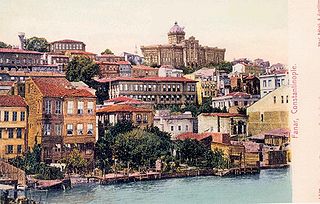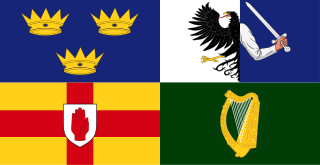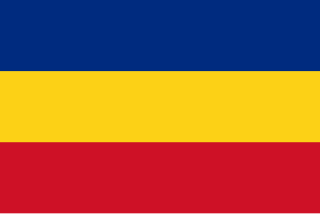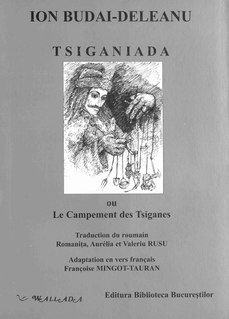Related Research Articles
This article covers the history and bibliography of Romania and links to specialized articles.

Alexandru Ioan Cuza was the first domnitor (Ruler) of the Romanian Principalities through his double election as prince of Moldavia on 5 January 1859 and prince of Wallachia on 24 January 1859, which resulted in the unification of both states. He was a prominent figure of the Revolution of 1848 in Moldavia. Following his double election, he initiated a series of reforms that contributed to the modernization of Romanian society and of state structures.

Moldavia is a historical region and former principality in Central and Eastern Europe, corresponding to the territory between the Eastern Carpathians and the Dniester River. An initially independent and later autonomous state, it existed from the 14th century to 1859, when it united with Wallachia as the basis of the modern Romanian state; at various times, Moldavia included the regions of Bessarabia, all of Bukovina and Hertsa. The region of Pokuttya was also part of it for a period of time.

Wallachia or Walachia is a historical and geographical region of Romania. It is situated north of the Lower Danube and south of the Southern Carpathians. Wallachia is traditionally divided into two sections, Muntenia and Oltenia. Wallachia as a whole is sometimes referred to as Muntenia through identification with the larger of the two traditional sections.
This article contains information about the literary events and publications of 1890.

Vlad III, commonly known as Vlad the Impaler or Vlad Dracula, was Voivode of Wallachia three times between 1448 and his death in 1476/77. He is often considered one of the most important rulers in Wallachian history and a national hero of Romania.

Phanariots, Phanariotes, or Fanariots were members of prominent Greek families in Phanar, the chief Greek quarter of Constantinople where the Ecumenical Patriarchate is located, who traditionally occupied four important positions in the Ottoman Empire: Voivode of Moldavia, Voivode of Wallachia, Grand Dragoman, and Grand Dragoman of the Fleet. Despite their cosmopolitanism and often-Western education, the Phanariots were aware of their Greek ancestry and culture; according to Nicholas Mavrocordatos' Philotheou Parerga, "We are a race completely Hellenic".

Danubian Principalities was a conventional name given to the Principalities of Moldavia and Wallachia, which emerged in the early 14th century. The term was coined in the Habsburg Monarchy after the Treaty of Küçük Kaynarca (1774) in order to designate an area on the lower Danube with a common geopolitical situation. The term was largely used then by foreign political circles and public opinion until the union of the two Principalities (1859). Alongside Transylvania, the United Principalities of Moldavia and Wallachia became the basis for the Kingdom of Romania, and by extension the modern nation-state of Romania.

Bucur is the legendary Romanian shepherd who is said to have founded Bucharest, giving it his name. While the legend about the shepherd is probably apocryphal, the name of the city is actually quite likely derived from a person named Bucur, as the suffix -ești is used for settlements derived from personal names, usually of the owner of the land or of the founder, though it is more likely that Bucur was the noble who owned the land.

Radu Mihnea was Voivode (Prince) of Wallachia between September 1601 and March 1602, and again between March and May 1611, September 1611 and August 1616, August 1620 and August 1623, and Voivode (Prince) of Moldavia in 1616–1619, 1623–1626. He was the illegitimate son of Mihnea Turcitul by Voica Bratcul.

Gheorghe Bibescu was a hospodar (Prince) of Wallachia between 1843 and 1848. His rule coincided with the revolutionary tide that culminated in the 1848 Wallachian revolution.

Abhartach, also Avartagh, is an early Irish legend, which was first collected in Patrick Weston Joyce's The Origin and History of Irish Names of Places (1870). Abhartach should not be confused with the similarly named Abartach, a figure associated with Fionn mac Cumhaill.

Regulamentul Organic was a quasi-constitutional organic law enforced in 1831–1832 by the Imperial Russian authorities in Moldavia and Wallachia. The document partially confirmed the traditional government and set up a common Russian protectorate which lasted until 1854. The Regulamentul itself remained in force until 1858. Conservative in its scope, it also engendered a period of unprecedented reforms which provided a setting for the Westernization of the local society. The Regulamentul offered the two Principalities their first common system of government.
The Albanians are an ethnic minority in Romania. As an officially recognized ethnic minority, Albanians have one seat reserved in the Romanian Chamber of Deputies to the League of Albanians of Romania.
Slavery existed on the territory of present-day Romania from before the founding of the principalities of Wallachia and Moldavia in 13th–14th century, until it was abolished in stages during the 1840s and 1850s, and also until 1783, in Transylvania and Bukovina. Most of the slaves were of Roma (Gypsy) ethnicity. Particularly in Moldavia there were also slaves of Tatar ethnicity, probably prisoners captured from the wars with the Nogai and Crimean Tatars.

Bulgarians are a recognized minority in Romania, numbering 7,336 according to the 2011 Romanian census, down from 8,025 in 2002. Despite their low census number today, Bulgarians from different confessional and regional backgrounds have had ethnic communities in various regions of Romania, and during the Middle Ages Bulgarian culture has exerted considerable influence on its northern neighbour. According to one estimate, Romanian citizens of Bulgarian origin number around 250,000.

The United Principalities of Moldavia and Wallachia, commonly called United Principalities, was the personal union of the Principality of Moldavia and the Principality of Wallachia, formed on 5 February [O.S. 24 January] 1859 when Alexandru Ioan Cuza was elected as the Domnitor of both principalities, which were autonomous but still vassals of the Ottoman Empire and which resulted in the unification of both principalities. On 3 February [O.S. 22 January] 1862, Moldavia and Wallachia formally united to create the Romanian United Principalities, the core of the Romanian nation state.

Nicholas Mavrocordatos was a Greek member of the Mavrocordatos family, Grand Dragoman to the Divan (1697), and consequently the first Phanariote Hospodar of the Danubian Principalities, Prince of Moldavia, and Prince of Wallachia. He was succeeded as Grand Dragoman (1709) by his brother John Mavrocordato (Ioan), who was for a short while hospodar in both Wallachia and Moldavia.

The boyars of Moldavia and Wallachia were the nobility of the Danubian Principalities of Moldavia and Wallachia. The title was either inherited or granted by the Hospodar, often together with an administrative function. The boyars held much of the political power in the principalities and, until the Phanariote era, they elected the Hospodar. As such, until the 19th century, the system oscillated between an oligarchy and an autocracy with the power concentrated in the hospodar's hands.

Ion Budai-Deleanu was a Romanian scholar, philologist, historian, and poet.
References
- 1 2 Florescu, Radu R. (2021), The Struggle Against Russia in the Romanian Principalities, Centre for Romanian Studies, pp. 94 & 95, ISBN 9781592110261
- ↑ Review. - Wilkinson's Wallachia and Moldavia, The Gentleman's Magazine, Volume 129, 1821
- ↑ W. G. East (30 June 2011). The Union of Moldavia and Wallachia, 1859: An Episode in Diplomatic History. Cambridge University Press. p. 181. ISBN 978-1-107-60131-4.
- ↑ Alfred C. Wood (13 May 2013). A History of the Levant Company. Routledge. p. 196. ISBN 978-1-136-23734-8.
- ↑ An account of the principalities of Wallachia and Moldavia - William Wilkinson, Longman, 1820 (Google Free eBook)
- ↑ Vesna Goldsworthy (1998). Inventing Ruritania: The Imperialism of the Imagination. Yale University Press. p. 77. ISBN 978-0-300-07312-6.
- ↑ Mark Jenkins (2010). Vampire Forensics: Uncovering the Origins of an Enduring Legend. National Geographic. p. 57. ISBN 978-1-4262-0607-8.
- ↑ Lucia Patrizio Gunning (2009). The British Consular Service in the Aegean and the Collection of Antiquities for the British Museum. Ashgate Publishing, Ltd. p. 35. ISBN 978-0-7546-6023-1.
- ↑ The Gentleman's Magazine. R. Newton. 1837. p. 669.